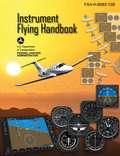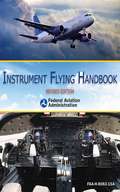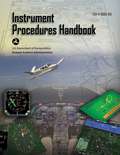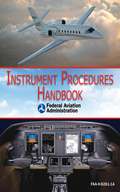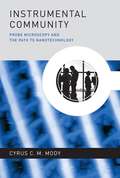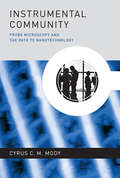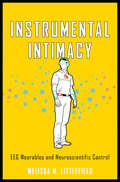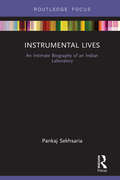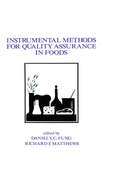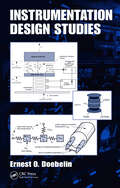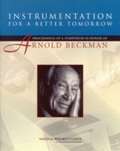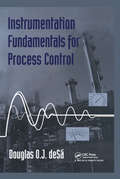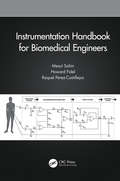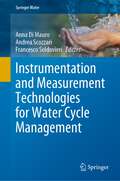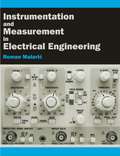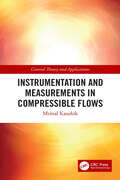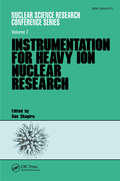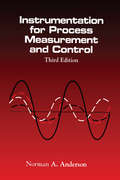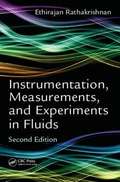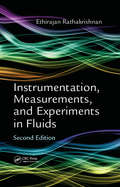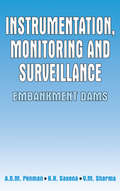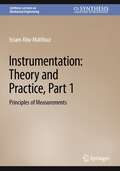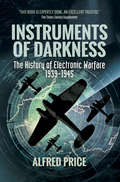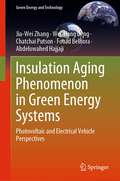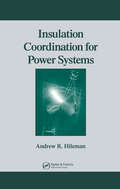- Table View
- List View
Instrument Flying Handbook (Federal Aviation Administration): FAA-H-8083-15B
by Federal Aviation AdministrationThis is the FAA's primary pilot resource for instrument flight rules and training. It (IFR) covers everything pertinent to operating an aircraft, both in instrument meteorological conditions (IMC) and without reference to outside visuals, relying solely on the information gleaned from the cockpit. Information applies to both analog and electronic flight displays, and is organized into separate coverage of the traditional and pictorial displays.Instrument Flying Handbook includes chapters on national airspace system, the air traffic control system, human factors, aerodynamics, flight instruments, flight maneuvers for IFR operations, navigation, emergency operations, as well as helicopter operations and more. Advanced systems are covered, including flight management systems, the primary flight display (PFD) and multi-function display (MFD), synthetic vision, and traffic advisory systems. Instrument clearance shorthand is discussed, and an instrument training lesson guide is provided.The Instrument Flying Handbook is designed for use by flight instructors, pilots preparing for the Instrument Rating FAA Knowledge and Practical Exams, and instrument-rated pilots looking for a refresher or preparing for an Instrument Proficiency Check (IPC). This edition features with full-color illustrations and diagrams, along with a comprehensive glossary and index.
Instrument Flying Handbook: Revised Edition
by Federal Aviation AdministrationThe Federal Aviation Administration’s Instrument Flying Handbook provides pilots, student pilots, aviation instructors, and controllers with the knowledge and skills required to operate an aircraft in instrument meteorological conditions.This up-to-date edition is illustrated with full-color graphics and photographs and covers topics such as basic atmospheric science, the air traffic control system, spatial disorientation and optical illusions, flight support systems, and emergency responses. The book’s two appendixes contain information on clearance shorthand and an instrument training lesson guide. Readers will also find a handy glossary and index.Since many questions on FAA exams are taken directly from the information presented in this text, the Instrument Flying Handbook is a great study guide for potential pilots looking for certification and a perfect gift for any aircraft or aeronautical buff.Additional topics included throughout this text include:Ground-based radar navigationApproaches to civil airportsFlying and landing in difficult weather conditionsAircraft system malfunctionsAirspace classificationDifferential global positioning systemsAnd many more!
Instrument Procedures Handbook: FAA-H-8083-16A (FAA Handbooks Ser.)
by Federal Aviation AdministrationThis is the new 2015 edition of the FAA's previous "Instrument Procedures Handbook" (previously the FAA-H-8083-16).This book covers all of the information needed to operate safely within the airspace system. In the FAA's "Instrument Procedures Handbook" (#FAA-H-8083-16A) the emphasis is placed on operations and procedural information for real-world use, which makes this the next logical step for pilots after learning basic instrument skills from the FAA's "Instrument Flying Handbook" (#FAA-H-8083-15B). Using this book, pilots can more directly apply the concepts to their current flying situation, and learn how their acquired skills are best used in today’s IFR environment. Considered industry-wide as a top source for instrument procedures information and a "must read” for all instrument pilots, this new 2015 edition brings pilots the latest changes to procedures and even more insights and guidance on how to operate safely within the national airspace system. Detailed information is provided for every navigation receiver and phase of flight on the required precision necessary to stay within protected airspace and to make a successful approach.While it was designed as a reference for professional pilots, the specialized glossary, index, full-color illustrations and photographs in this book make it a valuable training aid for flight instructors, instrument pilots, and instrument students alike. Each topic covered is well-detailed and explained in user-friendly terms, along with full-color depictions to aid understanding.Instrument flight instructors, pilots, and students will need this resource since it is used as a reference for the Airline Transport Pilot and Instrument Knowledge Tests and for the Practical Test Standards. Whether a pilot is a seasoned professional or recently completed an Instrument Rating course, this FAA handbook is sure to encourage more precise instrument techniques and ultimately create a safer pilot.
Instrument Procedures Handbook: Faa-h-8083-16a (FAA Handbooks Ser.)
by Federal Aviation AdministrationDesigned as a technical reference for instrument-rated pilots who want to maximize their skills in an "Instrument Flight Rules” environment, this revised and up-to-date edition of the Federal Aviation Administration’s Instrument Procedures Handbook contains the most current information on FAA regulations, the latest changes to procedures, and guidance on how to operate safely within the National Airspace System in all conditions. Featuring an index, an appendix, a glossary, full-color photos, and illustrations, Instrument Procedures Handbook is the most authoritative book on instrument use anywhere.
Instrumental Community
by Cyrus C. M. ModyThe scanning tunneling microscope (STM) has been hailed as the "key enabling discovery for nanotechnology," the catalyst for a scientific field that attracts nearly $20 billion in funding each year. In Instrumental Community, Cyrus Mody argues that this technology-centric view does not explain how these microscopes helped to launch nanotechnology--and fails to acknowledge the agency of the microscopists in making the STM and its variants critically important tools. Mody tells the story of the invention, spread, and commercialization of scanning probe microscopy in terms of the networked structures of collaboration and competition that came into being within a diverse, colorful, and sometimes fractious community of researchers. By forming a community, he argues, these researchers were able to innovate rapidly, share the microscopes with a wide range of users, and generate prestige (including the 1986 Nobel Prize in Physics) and profit (as the technology found applications in industry). Mody shows that both the technology of probe microscopy and the community model offered by the probe microscopists contributed to the development of political and scientific support for nanotechnology and the global funding initiatives that followed. In the course of his account, Mody charts the shifts in U. S. science policy over the last forty years--from the decline in federal basic research funding in the 1970s through the rise in academic patenting in the 1980s to the emergence of nanotechnology discourse in the 1990s--that have resulted in today's increasing emphasis on the commercialization of academic research.
Instrumental Community: Probe Microscopy and the Path to Nanotechnology (Inside Technology)
by Cyrus C. ModyHow networked structures of collaboration and competition within a community of researchers led to the invention, spread, and commercialization of scanning probe microscopy.The scanning tunneling microscope (STM) has been hailed as the “key enabling discovery for nanotechnology,” the catalyst for a scientific field that attracts nearly $20 billion in funding each year. In Instrumental Community, Cyrus Mody argues that this technology-centric view does not explain how these microscopes helped to launch nanotechnology—and fails to acknowledge the agency of the microscopists in making the STM and its variants critically important tools. Mody tells the story of the invention, spread, and commercialization of scanning probe microscopy in terms of the networked structures of collaboration and competition that came into being within a diverse, colorful, and sometimes fractious community of researchers. By forming a community, he argues, these researchers were able to innovate rapidly, share the microscopes with a wide range of users, and generate prestige (including the 1986 Nobel Prize in Physics) and profit (as the technology found applications in industry).Mody shows that both the technology of probe microscopy and the community model offered by the probe microscopists contributed to the development of political and scientific support for nanotechnology and the global funding initiatives that followed. In the course of his account, Mody charts the shifts in U.S. science policy over the last forty years—from the decline in federal basic research funding in the 1970s through the rise in academic patenting in the 1980s to the emergence of nanotechnology discourse in the 1990s—that have resulted in today's increasing emphasis on the commercialization of academic research.
Instrumental Intimacy: EEG Wearables and Neuroscientific Control
by Melissa M. LittlefieldA critical examination of the rise of wearable EEG monitors.From Fitbits to GPS trackers, wearables promise to help us understand and improve ourselves in quantified ways. We count our steps, track our location, and even monitor our brain waves as we strive to achieve better fitness, clearer direction, or a more focused mind. But why do we rely on wearables to learn about ourselves? In Instrumental Intimacy, Melissa M. Littlefield questions our desire for mechanistic guidance by examining brain-based EEG wearables that promise to improve sleep, relationships, self-knowledge, and learning. Littlefield focuses specifically on EEGs’ transition out of the laboratory and into the hands of consumers. While other brain-imaging technologies (such as MRI, PET, and MEG) are used only in specialized laboratories, human electroencephalography (a.k.a. EEG) is embedded in portable, user-friendly devices. These direct-to-consumer wearables visualize brain activity as accessible data, and many offer the promise of self-optimization.Littlefield’s illuminating book brings the histories of EEG to bear on the contemporary development of EEG wearables via case studies of EEG-based sleep aids, bio-mapping instruments, fashionable surveillance tools, and athletic training devices. The author argues that, over the past century, applied uses of EEG helped to create new states of mind to be monitored and manipulated, as well as discourses about the existence of brain waves and their viability as a tool for brain optimization. By contextualizing and analyzing EEG wearables, Instrumental Intimacy provides a crucial intervention in an emergent consumer market and in the scholarly fields of STS, critical neuroscience, and the history of technology.
Instrumental Lives: An Intimate Biography of an Indian Laboratory (Routledge Focus on Modern Subjects)
by Pankaj SekhsariaInstrumental Lives is an account of instrument making at the cutting edge of contemporary science and technology in a modern Indian scientific laboratory. For a period of roughly two-and-half decades, starting the late 1980s, a research group headed by CV Dharmadhikari in the physics department at the Savitribai Phule University, Pune, fabricated a range of scanning tunnelling and scanning force microscopes including the earliest such microscopes made in the country. Not only were these instruments made entirely in-house, research done using them was published in the world's leading peer reviewed journals, and students who made and trained on them went on to become top class scientists in premier institutions. The book uses qualitative research methods such as open-ended interviews, historical analysis and laboratory ethnography that are standard in Science and Technology Studies (STS), to present the micro-details of this instrument making enterprise, the counter-intuitive methods employed, and the unexpected material, human and intellectual resources that were mobilised in the process. It locates scientific research and innovation within the social, political and cultural context of a laboratory's physical location and asks important questions of the dominant narratives of innovation that remain fixated on quantitative metrics of publishing, patenting and generating commerce. The book is a story as much of the lives of instruments and their deaths as it is of the instrumentalities that make those lives possible and allow them to live on, even if with a rather precarious existence.
Instrumental Methods for Quality Assurance in Foods (Food Science And Technology Ser.)
by FungUpdated versions of papers delivered to a 1988 meeting of food technologists in Dallas, plus a few added chapters, survey the instruments and methodologies available for the instrumental analysis of chemical, physical, and microbiological aspects of food, especially in quality assurance and control
Instrumentation Design Studies
by Ernest DoebelinIntegrating physical modeling, mathematical analysis, and computer simulation, Instrumentation Design Studies explores a wide variety of specific and practical instrumentation design situations. The author uses MATLAB and SIMULINK for dynamic system simulation, Minitab for statistical applications, and Mathcad for general engineering computations.
Instrumentation For A Better Tomorrow: Proceedings Of A Symposium In Honor Of Arnold Beckman
by National Research Council of the National AcademiesOn November 15, 2004, the National Academies sponsored a symposium at the Beckman Center in honor of Arnold O. Beckman. The symposium concentrated on the wide-ranging practical applications of scientific instrumentation as was the focus of much of Arnold Beckman’s career. The report begins with two presentations: a remembrance by Arnold Beckman’s daughter, Pat, and an overview of his life and accomplishments by Arnold Thackray, President of the Chemical Heritage Foundation. The next section contains presentations on the application of instrumentation in seven, diverse areas: organic chemistry, molecular and systems biology, synchrotron x-ray sources, nanoscale chemistry, forensics, and clinical medicine. Finally, there is a summary of a panel discussion on the evolving relationship between instrumentation and research.
Instrumentation Fundamentals for Process Control
by Douglas O. deSaA practical introductory guide to the principles of process measurement and control. Written for those beginning a career in the instrumentation and control industry or those who need a refresher, the book will serve as a text or to supercede the mathematical treatment of control theory that will continue to be essential for a well-rounded understanding. The book will provide the reader with the ability to recognize problems concealed among a mass of data and provide minimal cost solutions, using available technology.
Instrumentation Handbook for Biomedical Engineers
by Mesut SahinThe book fills a void as a textbook with hands-on laboratory exercises designed for biomedical engineering undergraduates in their senior year or the first year of graduate studies specializing in electrical aspects of bioinstrumentation. Each laboratory exercise concentrates on measuring a biophysical or biomedical entity, such as force, blood pressure, temperature, heart rate, respiratory rate, etc., and guides students though all the way from sensor level to data acquisition and analysis on the computer. The book distinguishes itself from others by providing electrical circuits and other measurement setups that have been tested by the authors while teaching undergraduate classes at their home institute over many years. Key Features:• Hands-on laboratory exercises on measurements of biophysical and biomedical variables• Each laboratory exercise is complete by itself and they can be covered in any sequence desired by the instructor during the semester• Electronic equipment and supplies required are typical for biomedical engineering departments • Data collected by undergraduate students and data analysis results are provided as samples• Additional information and references are included for preparing a report or further reading at the end of each chapter Students using this book are expected to have basic knowledge of electrical circuits and troubleshooting. Practical information on circuit components, basic laboratory equipment, and circuit troubleshooting is also provided in the first chapter of the book.
Instrumentation and Measurement Technologies for Water Cycle Management (Springer Water)
by Andrea Scozzari Francesco Soldovieri Anna Di MauroThis book aims at presenting a unified framework for the description of working principles, recent advances and applications of cutting-edge measurement technologies for the water sector. Instrumentation and measurement technologies are currently playing a key role in the monitoring, assessment and protection of environmental resources. Measurement techniques and sensing methods for the observation of water systems are rapidly evolving and are requiring an increased multi-disciplinary participation.The whole water sector is characterised by multiple technological contexts concerning the monitoring of the resource, given the broad coverage that includes water from its natural domains to the men-made infrastructures. In particular, instrumentation and measurement technologies have a pervasive presence in all the necessary aspects for the assessment, monitoring and control of the water resource and of its relationship with the various environmental stressors, including the anthropic pressures.Therefore, the book aims at presenting how the diagnostics/monitoring methodologies and the related technologies can give an answer to the issues raised by the complex scenario characterising the water cycle management (WCM). The book is structured in five topical sections, grouped by similarity of their technological and/or applicative contexts.
Instrumentation and Measurement in Electrical Engineering
by Roman MalaricThe inclusion of an electrical measurement course in the undergraduate curriculum of electrical engineering is important in forming the technical and scientific knowledge of future electrical engineers. This book explains the basic measurement techniques, instruments, and methods used in everyday practice. It covers in detail both analogue and digital instruments, measurements errors and uncertainty, instrument transformers, bridges, amplifiers, oscilloscopes, data acquisition, sensors, instrument controls and measurement systems. The reader will learn how to apply the most appropriate measurement method and instrument for a particular application, and how to assemble the measurement system from physical quantity to the digital data in a computer. The book is primarily intended to cover all necessary topics of instrumentation and measurement for students of electrical engineering, but can also serve as a reference for engineers and practitioners to expand or refresh their knowledge in this field.
Instrumentation and Measurements in Compressible Flows (Control Theory and Applications)
by Mrinal KaushikInstrumentation and Measurements in Compressible Flows presents detailed information on experiments in compressible fluid flows including technical information pertaining to a wide variety of applications and the experimental basis for compressible flows. A step-by-step procedure is given to estimate the measurement errors as well as the uncertainty. Computational fluid dynamics data can be validated with the experimental results presented in the book. Further, it answers most pertinent queries related to conducting experiments and measuring the data at very high speeds. This volume also includes MATLAB® programs for selected topics. Features: Presents detailed coverage of instrumentation, measurements, and experiments in compressible flows Covers both experimental and applied aspects of gas dynamics Provides a real-time exposure to the modern supersonic and hypersonic wind tunnel applications Explains supersonic and hypersonic shock/boundary-layer interactions and their control Includes real-time experimental problems and their analysis This book is aimed at researchers and graduate students in aerospace and mechanical engineering.
Instrumentation for Heavy Ion Nuclear Research
by Dan ShapiraReflecting the recent innovations in heavy ion detection systems, this volume presents the state of the art in these systems and discusses plans and techniques for new instrumentation to explore the newest frontier of heavy ion science - relativistic heavy ions. Topics covered include low mass detectors, the GSI magnetic spectrometer, the Berkeley high resolution ball and detectors for high energy heavy ion colliders.
Instrumentation for Process Measurement and Control, Third Editon
by Norman A. AndersonThe perennially bestselling third edition of Norman A. Anderson's Instrumentation for Process Measurement and Control provides an outstanding and practical reference for both students and practitioners. It introduces the fields of process measurement and feedback control and bridges the gap between basic technology and more sophisticated systems. Keeping mathematics to a minimum, the material meets the needs of the instrumentation engineer or technician who must learn how equipment operates. I t covers pneumatic and electronic control systems, actuators and valves, control loop adjustment, combination control systems, and process computers and simulation
Instrumentation, Measurements, and Experiments in Fluids
by Ethirajan RathakrishnanMechanical engineers involved with flow mechanics have long needed an authoritative reference that delves into all the essentials required for experimentation in fluids, a resource that can provide fundamental review, as well as the details necessary for experimentation on everything from household appliances to hi-tech rockets. Instrumentation, Measurements, and Experiments in Fluids meets this challenge, as its author is not only a highly respected pioneer in fluids, but also possesses twenty years experience teaching students of all levels. He clearly explains fundamental principles as well the tools and methods essential for advanced experimentation.Reflecting an awe for flow mechanics, along with a deep-rooted knowledge, the author has assembled a fourteen chapter volume that is destined to become a seminal work in the field. Providing ample detail for self study and the sort of elegant writing rarely found in so thorough a treatment, he provides insight into all the vital topics and issues associated with the devices and instruments used for fluid mechanics and gas dynamics experiments. Extremely organized, this work presents easy access to the principles behind the science and goes on to elucidate the current research and findings needed by those seeking to make further advancement. Unique and Thorough Coverage of Uncertainty AnalysisThe author provides valuable insight into the vital issues associated with the devices used in fluid mechanics and gas dynamics experiments. Leaving nothing to doubt, he tackles the most difficult concepts and ends the book with an introduction to uncertainty analysis.Structured and detailed enough for self study, this volume also provides the backbone for both undergraduate and graduate courses on fluids experimentation.
Instrumentation, Measurements, and Experiments in Fluids, Second Edition
by Ethirajan RathakrishnanInstrumentation, Measurements, and Experiments in Fluids, Second Edition is primarily focused on essentials required for experimentation in fluids, explaining basic principles, and addressing the tools and methods needed for advanced experimentation. It also provides insight into the vital topics and issues associated with the devices and instruments used for fluid mechanics and gas dynamics experiments. The second edition adds exercise problems with answers, along with PIV systems of flow visualization, water flow channel for flow visualization, and pictures with Schlieren and shadowgraph—from which possible quantitative information can be extracted. Ancillary materials include detailed solutions manual and lecture slides for the instructors.
Instrumentation, Monitoring and Surveillance: Embankment Dams
by A.D.M PenmanBesides giving an historical introduction to embankment dams the book describes the need for instrumentation, planning procurement and installation practices of instruments. The significance of visual inspection and techniques, of monitoring various parameters, seepage, pore pressure, surface and internal displacements, earth pressures and seismic behaviour, through instrumentation has been described. Collection and processing of data and their use for back analysis to check stability of a dam at various stages of construction and reservoir filling have been suggested. In addition to case histories quoted in various chapters, an exclusive chapter on select case histories has been added which describes the conventional and latest instruments that are being used and methods adopted for installation, monitoring and analyses of data.
Instrumentation: Principles of Measurements (Synthesis Lectures on Mechanical Engineering)
by Issam Abu-MahfouzThis book emphasizes simple and concise coverage of the fundamental aspects of measuring systems. It is designed to provide the reader with essential knowledge regarding signals, signal analysis, signal conditioning circuits, and data acquisition systems. The prerequisites are a basic knowledge of multivariable calculus, introductory physics, and a familiarity with basic electrical circuits and components. Delivers topics and techniques that are fundamental to the understanding of the measurement process. These include standards, dynamic characteristics of measuring devices, statistical analysis of data, uncertainty analysis, signal conditioning devices, transistors,and logic circuits, analog to digital converters. To aid in the understanding of the subject matter and related applications, the book chapters are complemented with examples and problems. Careful attention was paid to the details of figures and illustration to help enforce the learning objectives of this book.
Instruments of Darkness: The History of Electronic Warfare, 1939–1945
by Alfred PriceThe rapid evolution of radio and radar systems for military use during the Second World War, and devices to counter them, led to a technological battle that neither the Axis nor the Allied powers could afford to lose. The result was a continual series of thrusts, parries and counter-thrusts, as first one side then the other sought to wrest the initiative in the struggle to control the ether. This was a battle fought with strange-sounding weapons: 'Freya', 'Mandrel', 'Boozer' and 'Window'; and was characterised by the bravery, self-sacrifice and skill of those who took part in it. However, for many years the use of electronic-warfare systems during the conflict remained a closely guarded military secret. When that veil of secrecy was finally lifted, the technicalities of the subject meant that it remained beyond the reach of lay researchers and readers. Alfred Price, an aircrew officer with the RAF where he flew with V-Force and specialised in electronic warfare and air fighting tactics, was in the unique position to lift the lid on this largely unexplored aspect of the Second World War. When it was first published in 1967, Instruments of Darkness came to be regarded as a standard reference work on this intriguing subject. This completely revised edition concludes with the Japanese surrender in August 1945 and brings the analysis fully up to date in the light of what we now know. 'This book is expertly done. An excellent treatise.' The Times Literary Supplement
Insulation Aging Phenomenon in Green Energy Systems: Photovoltaic and Electrical Vehicle Perspectives (Green Energy and Technology)
by Jia-Wei Zhang Wei-Hang Deng Chatchai Putson Fouad Belhora Abdelowahed HajjajiThis book is a must-read for those interested in the aging phenomenon of materials used in new energy systems, such as photovoltaic and electric vehicles. It provides a fundamental framework for this topic and important basic data and references for insulation materials used in these systems. It covers the aging of photovoltaic systems installed in different environments, including space, as well as the aging of the discharge present in the drive motors of electric vehicles. This book is suitable for researchers and students interested in green energy systems and can be used for teaching, research, and science popularization.
Insulation Coordination for Power Systems (Power Engineering (Willis) #Vol. 9)
by Andrew R. HilemanThis detailed and comprehensive reference presents the latest developments in power system insulation coordination—emphasizing the achievement of optimum insulation strength at minimum cost. Comprehensively covering a myriad of insulation coordination techniques, the book examines electrical transmission and distribution lines and substations. Supplemented with end-of-chapter problem sets and over 1700 literature citations, tables, drawings, and equations, the book focuses on the conventional (or deterministic) method of insulation coordination, as well as the probabilistic method with its emphasis on statistical analysis.
